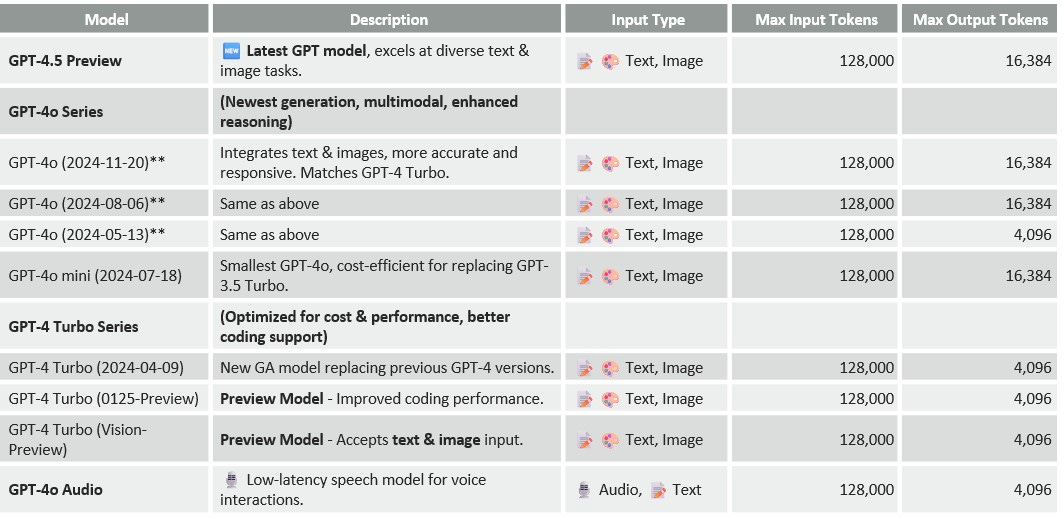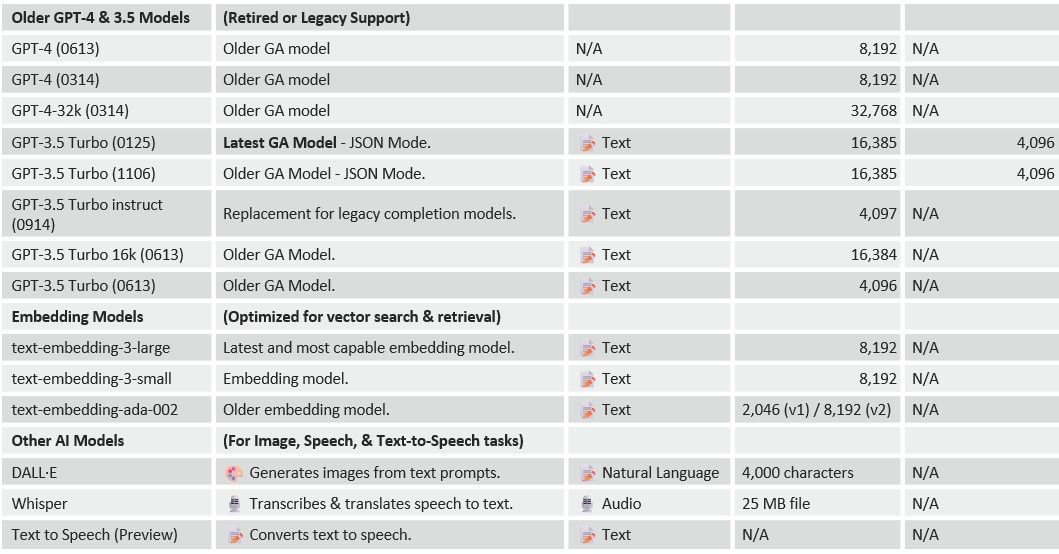A Comprehensive Guide to Azure OpenAI Service Models: Features, Capabilities, and Use Cases
The Azure OpenAI Service offers a diverse set of models with varying capabilities and price points.
The Azure OpenAI Service offers a diverse set of models with varying capabilities and price points. Model availability varies by region and cloud. This article provides an overview of the available models, their features, and potential use cases.
Model Overviews
GPT-4.5 Preview: The latest GPT model that excels at diverse text and image tasks. It offers structured outputs, prompt caching, tools, and streaming. It accepts text and image inputs and outputs. The context window is 128,000, with a max output of 16,384 tokens. Training data is up to October 2023.
o-series models: Reasoning models with advanced problem-solving and increased focus and capability, making them strong in science, coding, and math. They offer structured outputs and functions/tools.
o3-mini (2025-01-31): The latest reasoning model, offering enhanced reasoning abilities with text-only processing. Input: 200,000 tokens, Output: 100,000 tokens.
o1 (2024-12-17): The most capable model in the o1 series, offering enhanced reasoning abilities with text and image processing. Input: 200,000 tokens, Output: 100,000 tokens.
o1-mini (2024-09-12): A faster and more cost-efficient option in the o1 series, ideal for coding tasks. Input: 128,000 tokens, Output: 65,536 tokens.
GPT-4o & GPT-4 Turbo: The latest most capable Azure OpenAI models with multimodal versions, which can accept both text and images as input.
GPT-4o: Integrates text and images, enhancing accuracy and responsiveness. It matches GPT-4 Turbo in English text and coding tasks but offers superior performance in non-English languages and vision tasks. Enhanced creative writing ability. Input: 128,000, Output: 16,384.
GPT-4 Turbo: A large multimodal model that can solve difficult problems with greater accuracy. Optimized for chat and traditional completions tasks.
GPT-4o audio: Supports either low-latency, "speech in, speech out" conversational interactions or audio generation.
GPT-4o real-time audio: Designed for real-time, low-latency conversational interactions.
GPT-4o audio completion: Designed to generate audio from audio or text prompts.
Examples include:
gpt-4o-mini-audio-preview (2024-12-17): Audio model for audio and text generation. Input: 128,000, Output: 4,096.
gpt-4o-mini-realtime-preview (2024-12-17): Audio model for real-time audio processing. Input: 128,000, Output: 4,096.
gpt-4o-audio-preview (2024-12-17): Audio model for audio and text generation. Input: 128,000, Output: 4,096.
gpt-4o-realtime-preview (2024-12-17): Audio model for real-time audio processing. Input: 128,000, Output: 4,096.
GPT-3.5: Can understand and generate natural language or code.
GPT-3.5 Turbo: The most capable and cost-effective model in the GPT-3.5 family, optimized for chat and works well for traditional completions tasks.
Embeddings: Models that can convert text into numerical vector form to facilitate text similarity.
text-embedding-3-large: The latest and most capable embedding model.
text-embedding-3-small.
text-embedding-ada-002.
DALL-E: Models that can generate original images from natural language. DALL-E 3 is generally available. Max Request: 4,000 characters.
Whisper: Models in preview that can transcribe and translate speech to text. Max Request: 25 MB audio file size.
Text to speech (Preview): Models in preview that can synthesize text to speech.
tts: Optimized for speed.
tts-hd: Optimized for quality.
Detailed Sections for Key Models
GPT-4.5 Preview
The GPT-4.5 Preview is the latest GPT model that excels at diverse text and image tasks.
Access: Requires registration and is granted based on Microsoft's eligibility criteria.
Availability: East US 2 and Sweden Central.
Capabilities: 128,000 context window and 16,384 max output tokens. It offers structured outputs, prompt caching, tools, and streaming.
o-series Models
The Azure OpenAI o-series models are designed to tackle reasoning and problem-solving tasks.
Focus: Strong in areas like science, coding, and math.
Access: Access to o3-mini and o1 requires registration.
Key Models:
o3-mini (2025-01-31): Enhanced reasoning abilities.
o1 (2024-12-17): Most capable model in the o1 series.
o1-mini (2024-09-12): Faster and more cost-efficient, ideal for coding tasks.
GPT-4o and GPT-4 Turbo
GPT-4o integrates text and images in a single model, enhancing accuracy and responsiveness.
GPT-4o: Superior performance in non-English languages and vision tasks compared to GPT-4 Turbo. Enhanced creative writing ability.
GPT-4 Turbo: A large multimodal model optimized for chat and traditional completions tasks.
Access: Available for standard and global-standard model deployment.
GPT-4o Audio
GPT-4o audio models support low-latency conversational interactions and audio generation.
GPT-4o real-time audio: Designed for real-time, low-latency conversational interactions.
GPT-4o audio completion: Designed to generate audio from audio or text prompts.
Embedding Models
These models convert text into numerical vector form for text similarity tasks.
text-embedding-3-large: The latest and most capable embedding model.
Dimensions Parameter: Supports reducing the size of the embedding via a new dimensions parameter.
Model Availability and Deployment
Deployment Types: Standard and Provisioned.
Global Standard: Offered with a global deployment option, routing traffic globally to provide higher throughput.
Provisioned: Offered with a global deployment option, allowing customers to purchase and deploy provisioned throughput units across Azure global infrastructure.
o-series Models: Most o-series models are limited access and require registration.
Refer to the model summary table and region availability sections for specific model availability in different regions.
Using the Models
Access: Via Chat Completions API, Embedding API, Image Generation, Audio, and Completions (Legacy).
Fine-tuning: Supported regions and token limits vary by model. For example, gpt-35-turbo (0613) fine-tuning is available in East US2, North Central US, Sweden Central, and Switzerland West, with a max request of 4,096 tokens.
Assistants (Preview): Supported models and regions are available in the Assistants API, SDK, and Azure AI Foundry.
Cautions and Important Notes
Preview Models: Not recommended for use in production. Preview models do not follow the standard Azure OpenAI model lifecycle.
Embedding Models: Upgrading between embedding models is not possible.
GPT-4 Turbo: The provisioned version is currently limited to text only.
Conclusion
Azure OpenAI Service models offer a wide range of capabilities for various AI applications. Understanding the features, availability, and deployment options is crucial for leveraging these models effectively. Explore the models further and consider specific needs and use cases
Happy Reading :)






